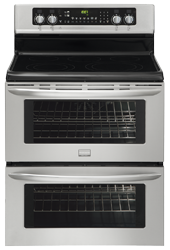Range Repair Guide
 For the DIY-inclined, the below guides will assist in completing simple repairs on your oven, stove, or range. It is impossible to write guides applicable for every model of range, so in some cases there may be additional steps required to complete repairs.
For the DIY-inclined, the below guides will assist in completing simple repairs on your oven, stove, or range. It is impossible to write guides applicable for every model of range, so in some cases there may be additional steps required to complete repairs.
DISCLAIMER: Appliance Repair can be dangerous, especially when dealing with electricity. The electrical current generated from wall outlets can be enough to kill someone. Please exercise extreme caution when working with appliances. GSAR cannot be held liable for injuries due to misuse of our repair guides.
How to Fix an Oven/Range That Will Not Bake or Broil
The below guide is also applicable to replacing broil elements. Removal of broil elements can be trickier because the broil element is suspended. Since the element is suspended and hanging, make sure to remove additional screws and brackets that are holding the element up before proceeding.
For Gas Ranges:
Try the broil function. If broil is working but bake is not, the bake igniter will likely need replacement. If broil is not working, there may be a valve issue or electronic control problem. In rare cases, both the bake and broil igniters are defective.
For Electric Ranges:
Try the broil function. If broil is working but bake is not, the heating element will likely need replacement. If the heating element is exposed, it should glow red if it is working. The heating element should be emanating heat — be careful not to burn yourself! In rarer cases, the element will not heat due to a failed control thermostat or control board. Defective heating elements often show visible signs of damage, such as cracks.
How to Replace an Electric Range’s Heating Element:
- Unplug the range and make sure the unit is no longer receiving electricity.
- Remove all oven racks and set aside.
- Look at back wall in the inside of the oven cavity. There should be screws that hold the element in. The screws are either Phillips-head screws but some models will require a ratchet to remove.
- Remove screws that hold the element in. Remove them carefully because the metal screws can strip and make it very difficult to remove. If the screws are too tight to remove, spray a very small amount of WD40 around the screw head. Use the spray straw that comes with the can. This helps to lubricate to allow for easier removal.
- Carefully pull the element out in order to access the wire connections. Make sure to pull it out slowly to avoid pulling the connectors off and losing them behind the oven cavity wall.
- Remove both wires from the element terminals. Some elements have terminal connections that can simply be pulled off; others will require unscrewing.
- Take out the disconnected element.
- Follow the length of the element with your fingers looking for signs of damage.
- Find the model and serial number on the range, make sure to write them down to acquire the correct part. Parts can be acquired locally at appliance parts suppliers and also online.
- Replace the element by repeating the above steps in reverse. When connecting the new element to the terminals, make sure that the connection is not loose. If the connection is loose, it can cause arcing of electricity when the element is energized.
- Plug the oven back in and test the bake feature.
- If the element is heating again, you’re all set. If the element still isn’t heating, the range may have a failed control thermostat, control board, or possibly another issue. Repairs and diagnosis for these parts is more involved, so we recommend calling an appliance technician.
While removing the element, you may notice damage to the wire connection at the element terminal. If this is the case, this damaged connection can be repaired and the original element can be reinstalled.
Diagnosing heating problems with gas ranges can be more difficult, and we typically do not recommend that consumers attempt this repair. It is best to reach out to an appliance repair professional who will complete repairs effectively and efficiently the first time.

